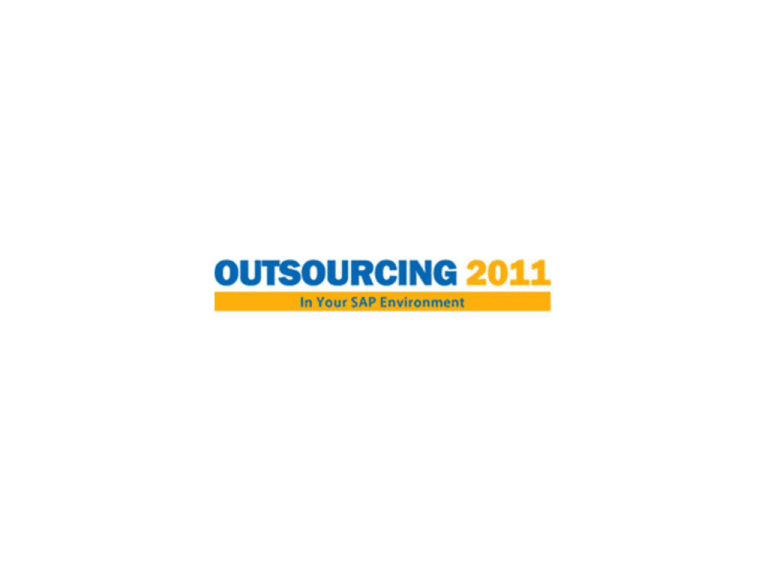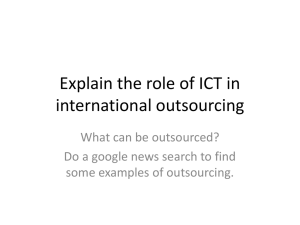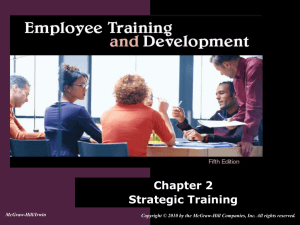
0
The key factors that
determine if and when
outsourcing is right for you
Dr. Berg
Comerit Inc.
© 2011 Wellesley Information Services. All rights reserved.
In This Session …
There are many issues that must be considered carefully before you
decide if outsourcing is the right for you.
This session explores how technology, supplier, cost and internal
factors impact the outsourcing decision making process.
Examine major factors that should affect your the outsourcing decision
Walk through a framework to help you make the correct outsourcing
decision for an system. Learn how the outsourcing decision is different
for every SAP environment and get a framework for deciding when to
keep systems in-house, when to outsource, when to evolve systems,
and when to retire them.
2
What We’ll Cover …
•
•
•
•
•
•
•
Background
When to Outsource a BI system
Cost, Supplier, Internal and Technology Factors
BI Outsourcing Vs. ERP Outsourcing
Impact to Jobs and IT Growth
Trends and Success Rates
Wrap up
Areas to Outsource
The focus of outsourcing has
been on tasks that require high
configuration, but causes few IT
problems in the organization.
Most has been in the
areas of System and
Infrastructure software.
The next wave of outsourcing
has been in the areas for
business applications, which as
substantially more complex.
4
What is being outsourced today?
While a focus has been on
application outsourcing, the
IT infrastructure and Basis
functions are close behind.
Today, over 50% of
companies have either
outsourced some of these
functions, or are planning to
do so over the next 12
months.
Outsourcing some core IT areas are becoming ‘mainstream’
5
Software-as-a-Service (SaaS) Changes 2009 - 2010
The number of companies who said that they
were using at least one SaaS application
increased from 47% to 60% in one-year.
Initially, the focus was on applications such as
email and CRM, but the trend for 2011 is
towards looking at other applications such as
Enterprise Resource Planning (ERP) and
Business Intelligence (BI) as well.
In 2006 there were very few options for
companies to do so, but now many of the major
ERP Vendors, including SAP, has their own
SaaS offerings.
6
The Growing Trend of Software as a Service - SAP
In February, 2011 SAP
released of its SaaS
(software as a service)
suite Business
ByDesign, in its 2.6
release.
The published base pricing was $149 per month per user, but this price
varies based on volume discounts and the functionality included.
It is a significant step towards allowing companies that use SAP to
“drink milk – without having to buy a cow”…
7
The Growing Trend of Cloud Computing
According to a report
from IDC, IT cloud
spending will expand
from $21.5 billion in
2010 to $72.9 billion
by 2015*
System Infrastructure (basis)
CRM
Application Deployment software
Collaboration services and software
Other Applications as a service
Business Intelligence
Financial Accounting & Payroll
Other HR Functions
Content delivery (i.e. material for web site)
Supply Chain Management
0.0%
5.0%
10.0%
15.0%
20.0%
25.0%
30.0%
This means that IT cloud services is growing at more than four times
the rate of the worldwide IT spending * (others have the overall
worldwide IT spending is increasing by 5.7% in 2010).
Research forecasts that one of every $7 spent on packaged software, service
and storage offerings in 2015 will be related to the public cloud model*
(*Source: IDC, Worldwide and Regional Public IT Cloud Services 2011-2015 Forecast, Doc #228485, June 2011)
8
What We’ll Cover …
•
•
•
•
•
•
•
Background
When to Outsource a BI system
Cost, Supplier, Internal and Technology Factors
BI Outsourcing Vs. ERP Outsourcing
Impact to Jobs and IT Growth
Trends and Success Rates
Wrap up
When to Outsource a BI system – BI Vs. ERP
As part of the outsourcing, many
companies are debating when to
outsource their BI tools as well.
This is a complex question that must
consider the competitive advantage
which a tool may provide.
The company must also account for
how ready the market is to support BI in
an outsourcing model.
The final direction should not solely be question of cost savings, but
must consider the benefits and the business strategy of the company.
10
A Framework for Deciding when to Outsource a BI system
• When making strategic decisions one should always have a
framework for examining alternatives.
• There are 4 possible decisions to an outsourcing evaluation.
We will look at each in detail.
11
The Four Decisions – 1) Eliminate the BI system
As the information volume is
increased, the quality of the
decisions improve.
However, once information
overload kicks-in, the quality
of the decision starts to
decline
The challenge of a BI organization is not to create more
information, but the correct amount to the right audience.
12
The Four Decisions – 1) Eliminate the BI system
Unfortunately, some custom BI tools are built
on a "nice-to-know" basis. These are systems
that do not measure what drives the business
but are satisfying some department's wants
instead of needs.
These are often found at regional levels or in
subsidiaries that are allowed to evolve their
legacy reporting tools over time.
Since these are not providing a competitive advantage and are often not required
from a regulatory standpoint, they should be eliminated from the organization.
These BI systems impact the
focus of the organization, and
benefits can be realized from
removing these distractions
13
The Four Decisions – 2) Keep SAP BI In House
Most companies aspire to build BI systems
that are so good that they become a source
for competitive insights that lead to an
advantage in the marketplace.
These tools can not be bought out of the box.
One can find them in critical areas of the organizations, such as lending policy
groups in banks, underwriters in insurance companies and production planning
groups in manufacturing companies.
For these systems it is important to maintain user flexibility and responsiveness.
Outsourcing these BI tools may lead to sharing "know-how" that can be made
available to competitors. These tools are best developed and maintained in house
14
The Four Decisions – 3) Evolve the BI System
Early adaptors of BI systems may experience a
period of competitive advantages.
However, as the rest of the industry adapts
these tools, the systems are no longer a source
of competitive advantage. They have become a
part of the "must-have" infrastructure.
To maintain a form of competitive advantage, these systems must continue
to evolve or risk becoming an industry commodity.
If the BI tool is allowed to become a commodity, and the competitive
advantage is surrendered, it will become a candidate for outsourcing.
We often find this type of analytical support tool in standardized process areas
such as shipping, receiving, call centers, customer interaction tracking, etc.
15
The Four Decisions – 4) Outsource BI and BW
Some BI tools that can be outsourced.
These are systems that serve the function of
monitoring the business, rather than
supporting complex business decisions.
These BI systems do not provide a competitive
advantage, but are essential for good "business
practices." They are often reactive in nature
As a result, they are required in the organization but not a source for future
growth or a focus of new business development. In addition, the technology
knowledge is available in the marketplace.
A company can realize substantial financial benefits of
removing these BI tools from their internal infrastructure.
16
What We’ll Cover …
•
•
•
•
•
•
•
Background
When to Outsource a BI system
Cost, Supplier, Internal and Technology Factors
BI Outsourcing Vs. ERP Outsourcing
Impact to Jobs and IT Growth
Trends and Success Rates
Wrap up
What to Consider - Cost Factors
Research has suggested that the overall costs of outsourcing have been
consistently underestimated by organizations.
However, a driving factor of outsourcing has been to reduce costs while
being able to provide the same level of service. Justifications include
beliefs that the outsourcer has better economies of scale, tighter control
over fringe benefits, better access to lower cost labor pools and a more
focused expertise in managing systems.
As labor costs are a function of an organization’s overall cost structure,
outsourcing is sometimes used to change the overall labor cost
structure for the whole organization.
In these cases, outsourcing may be used as a tool for an overall
reduction in compensation even for those jobs that remain
18
Supplier Factors
Supplier factors include the availability of
possible outsourcing partners, their expertise,
reliability and willingness to provide IT services
at a reasonable service level and at a low cost.
The trick to select an outsourcing partner is first
of all based on a level of trust and a making
sure that the partner will provide adequate
focus to your needs and issues.
Physical location, language, training and an
formal escalation process is also important.
There are over 872 IT outsourcing vendors of which 115
companies are providing some form of SAP outsourcing services
(Brown & Wilson, “The Black Book of Outsourcing”)
19
Internal Factors
Organizations are also looking at internal factors when
considering outsourcing
This include the need to sustain 24/7 operations,
and perceived improvements in flexibility and agility.
Processes that are outside the normal operations of a company, or that
are not deemed a good fit with the core operations of a business model,
are more likely to be outsourced.
Other internal factors may include an organization’s expertise with
outsourcing in general, or in a specific related area, as well as the
organization’s expertise in IS operations.
It is more likely that organizations that have little familiarity
with ERP or BI operations will outsource those functions
20
Technology Factors
Some organizations choose to outsource ERP and BI
systems due to uncertainty around technology choice,
and perceived task complexity.
Large-scale ERP systems have a high degree of complexity and a
number of organizations have, therefore, decided not to acquire these
systems.
Instead some are relying on outsourcing as a means to get access to
the ERP technology without making software or hardware purchases.
The lack of commitment to a specific system is often motivated
by perceptions regarding the frequency of technology changes
and uncertainty regarding the long-term strategic direction of the
organizations due to events such as mergers and divestitures.
21
Top 20 Reasons Given for Outsourcing
Research has found that
companies give a variety
of reasons for why they are
outsourcing.
The top 20 reasons can be
grouped into the four
factors:
Cost factors
Internal factor
Supplier factors
Technology factors
22
What We’ll Cover …
•
•
•
•
•
•
•
Background
When to Outsource a BI system
Cost, Supplier, Internal and Technology Factors
BI Outsourcing Vs. ERP Outsourcing
Impact to Jobs and IT Growth
Trends and Success Rates
Wrap up
Finding Real Answers
In order to explore what companies are really doing, we surveyed
participants at four national SAP conferences.
We distributed almost 2,400 surveys and got 1,889 responses.
We classified each company based on size
24
Competitive Strategies and Outsourcing
Companies operate under different
competitive strategies.
Some are low-cost providers, others
compete as a niche player or
differentiators.
The competitive strategy impacts
why you may consider outsourcing.
For example, low costs providers are
looking at costs, while
differentiators, may choose not to
outsource at all.
25
Findings – Company Size matters in Outsourcing
Fortune-500 companies
considered the cost
factor as most
important, regardless
of their strategy.
Fortune-1000 companies focus more on Internal factors
Smaller organization emphasize the supplier factors highest
Smaller companies seems to be more willing to following a pitch
from a supplier, while very large companies have the capabilities to
do this work themselves, but wants to reduce costs above all else.
26
The Most Important Factors to consider when outsourcing ERP
The most important factors when outsourcing ERP systems seems to be
focusing on the service providers. While technology uncertainly seems to
be the least motivator for outsourcing.
27
The Most Important Factors to consider when outsourcing BI
Despite articles to the contrary, technology choice or the complexity
of BI systems does not seem to be a factor when outsourcing these
systems.
28
There is a difference between outsourcing BI and ERP
Companies should not consider outsourcing “SAP”, but instead treat
ERP/OLTP and BI/DSS outsourcing as two separate decisions
29
Findings – Strategy and Outsourcing
There is a difference how each
company looks at cost savings,
internal, supplier and technology
factors.
This depends on the competitive
strategy of an organization
Strategy
Low Cost
Niche
Differentiator
Low Cost
-
Different
Different
Niche
Differentiator
Different
-
Different
Not Different
Not Different
-
Supplier Factors
Low Cost
Niche
Differentiator
Low Cost
-
Different
Different
Niche
Differentiator
Different
-
Different
Different
Different
-
Internal Factors
Low Cost
Niche
Differentiator
When deciding if outsourcing is
right for you, you have to look
at your competitive strategy
and company size, before you
decide what to focus on.
Cost Factors
Low Cost
-
Different
Different
Niche
Differentiator
Different
-
Different
Different
Different
-
Technology Factors
Low Cost
Niche
Differentiator
Low Cost
-
Different
Different
Niche
Differentiator
Different
-
Different
Different
Different
-
30
What We’ll Cover …
•
•
•
•
•
•
•
Background
When to Outsource a BI system
Cost, Supplier, Internal and Technology Factors
BI Outsourcing Vs. ERP Outsourcing
Impact to Jobs and IT Growth
Trends and Success Rates
Wrap up
The IT Jobs are Still growing in the USA
Despite an increase in outsoaring overseas, the number of IT jobs in the
USA is still growing and will continue to do so for the next 7 years
according to the US department of Labor statistics.
Occupation
Computer and Information Systems Managers
Software Developers, Applications
Computer Occupations, All Other
Computer software engineers, systems software
Computer Programmers
Computer Support Specialists
2008
2018
293,000
342,500
514,800
689,900
209,300
236,800
394,800
515,000
426,700
414,700
565,700
643,700
2,406,308 2,844,618
Annual
Growth
1.57%
2.97%
1.24%
2.69%
-0.28%
1.30%
1.69%
Average Salary
Total Growth
(2010)
$
123,280.00
16.9%
$
90,410.00
34.0%
$
79,790.00
13.1%
$
75,730.00
30.4%
$
74,900.00
-2.8%
$
49,930.00
13.8%
18.22%
$
82,340.00
* Projections by US Department of Labor, Sept, 2011
The overall growth in IT jobs is forecasted to be over 18% between 2008 and
2010, despite a recession. The only area decreasing is ‘programmers’.
32
Outsourcing and Recession had little impact on IT Workers
•
•
The IT outsourcing has also had limited impact on the salaries overall.
The national US average salary is $44,410 and IT professionals are
compensated between 20% and 300% higher.
2009
Employee Type
Computer and Information Research Scientists
Computer Systems Analysts
Computer Programmers
Software Developers, Applications
Software Developers, Systems Software
Database Administrators
Network and Computer Systems Administrators
Computer Support Specialists
Information Security Analysts, Web Developers, & Network
Computer Occupations, All Other
2010
# of
employees
26,130
512,720
367,880
495,500
385,200
108,080
338,890
540,560
226,080
195,890
Mean
Salaries
$105,370
$80,430
$74,690
$90,170
$96,620
$74,290
$70,930
$47,360
$76,560
$78,010
# of
employees
24,900
495,800
333,620
499,280
378,920
104,080
333,210
579,270
243,330
183,110
3,196,930
$79,443
3,175,520 $80,469
Mean
Salaries
$103,150
$81,250
$74,900
$90,410
$97,960
$75,730
$72,200
$49,930
$79,370
$79,790
* US Dept. of Labor Statistics 2011
In 2010, the number of jobs remained steady and salaries increased
by $1,026 on average for all IT professionals
What We’ll Cover …
•
•
•
•
•
•
•
•
Background
When to Outsource a BI system
Cost, Supplier, Internal and Technology Factors
BI Outsourcing Vs. ERP Outsourcing
Impact to Jobs and IT Growth
Technology Factors
Trends and Success Rates
Wrap up
How Much are Companies really Outsourcing ERP?
We found that companies spent between 12 and 14% of
their IT budgets on ERP outsourcing today.
However, they planned on increasing this to between
10% and 30% in the next 3 years.
The fastest growth in ERP outsourcing seems to
be from Fortune-500 companies.
35
How Much are Companies really Outsourcing BI?
We found that companies spent only between 3% and 6%
of their IT budgets on BI outsourcing today. This is less
than half of what they spend on ERP outsourcing.
However, they planned on increasing this to between 9% and 20%
in the next 3 years.
The fastest growth in BI outsourcing seems to also
come from Fortune-500 companies.
36
The Direction and Risk of BI Outsourcing
As the outsourcing wave of the transaction processing continues,
there are mounting pressures to seriously examine which BI tools can
be bundled into the outsourcing packages.
In this environment, it is important that companies do not blindly look
at cost savings, but also considers which BI tools are critical to their
competitive advantage.
A company that signs any deal based solely on cost savings can risk
becoming a commodity business with no real ability to take advantage
of future opportunities to distinguish themselves from the competition.
37
The Direction of BI Outsourcing
However, to blindly state that there are no
BW/BI tools that can be outsourced is
shortsighted.
A balanced view must be taken when
deciding where to draw the line between inhouse and outsourcing.
This decision should be based on the level of
maturity of the industry (as demonstrated by
standardization) as well as the competitive
standpoint of the company.
38
The Success Rate of IT Outsourcing
About 50% of all
outsourcing efforts are
considered a success,
while many efforts does
not yield few
improvements.
To improve on these
statistics, it is important
to write a comprehensive
Service Level Agreement
(SLA) with objective
performance targets
Source: AMR Research, 2010
39
What We’ll Cover …
•
•
•
•
•
•
•
•
Background
When to Outsource a BI system
Cost, Supplier, Internal and Technology Factors
BI Outsourcing Vs. ERP Outsourcing
Impact to Jobs and IT Growth
Technology Factors
Trends and Success Rates
Wrap up
Resources
•
European Journal of Information Systems. “Factors considered when
outsourcing an IS system: an empirical examination of the impacts of organizational size,
strategy and the object of a decision” By Drs. Berg and Stylianou
•
http://www.palgrave-journals.com/ejis/journal/v18/n3/abs/ejis200918a.html
Outsourcing SAP Operations, SAP PRESS by Yosh Eisbart ISBN:978-159229-284-4.
•
The Black Book of Outsourcing
http://www.sap-press.com/products/Outsourcing-SAP-Operations.html
http://www.theblackbookofoutsourcing.com
CIO Magazine – Outsourcing Success Measures
http://www.cio.com/topic/3195/Outsourcing
41
7 points to take home
1. Outsourcing is a part of most companies business strategy
2. You have to decide between complete outsourcing, SaaS, Cloud
and partial outsourcing
3. ERP and BI outsourcing are different and should be treated so
4. Your organization size and strategy should determining what
and how you outsource
5. Cost reduction should be just one of many measures
6. Writing a solid SLA is critical to outsourcing success
7. Trust in a supplier and supplier’s personal focus is very
important in any outsourcing partnership
42
Your Turn!
How to contact me:
Dr. Berg
Bberg@ComeritInc.com
43
Disclaimer
SAP, R/3, mySAP, mySAP.com, SAP NetWeaver®, Duet™®, PartnerEdge, and other SAP products and services mentioned herein as well as their
respective logos are trademarks or registered trademarks of SAP AG in Germany and in several other countries all over the world. All other product
and service names mentioned are the trademarks of their respective companies. Wellesley Information Services is neither owned nor controlled by
SAP.
44







